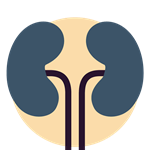
Diagnosis
How is nephropathic cystinosis diagnosed?

Cystinosis can be diagnosed using a test that looks at the levels of cystine in white blood cells. White blood cells are used because they are a well-known place of cystine accumulation and are easy to obtain via a blood test. If there is a high level of cystine in these cells, the diagnosis of cystinosis can be confirmed.1,2

A slit-lamp examination may also be carried out to look for eye crystals which appear by 1–2 years of age. This examination may be the initial criterion for diagnosing patients with late-onset cystinosis.1,2

If available, genetic testing for gene mutations confirms the diagnosis and characterises the specific mutation a patient has. Genetic testing may also be able to detect cystinosis in unborn babies (antenatal screening in at-risk pregnancies).2,3
It’s important that a diagnosis of cystinosis is made as soon as possible. This helps the patient get prompt treatment to prevent long-term complications.1
Cystinosis should be suspected in children who show signs of renal Fanconi syndrome and don’t gain weight as they should (failure to thrive), experience growth retardation (short stature and poor weight gain are common), or show signs of loss of appetite or rickets.1,2
How important is Fanconi syndrome when diagnosing nephropathic cystinosis?
Since cystinosis is the most common reason for renal Fanconi syndrome at this age, this differential diagnosis should always be considered. Cystinosis should be suspected in all patients with failure to thrive and signs of renal Fanconi syndrome.2
‘Red flag’ early symptoms
•
Excessive urine production (polyuria)2
•
Excessive thirst (polydipsia)2
•
Dehydration2
•
Loss of electrolytes in urine2
•
Amino acids present in urine (aminoaciduria)2
•
Growth retardation1,2
•
Rickets1,2





